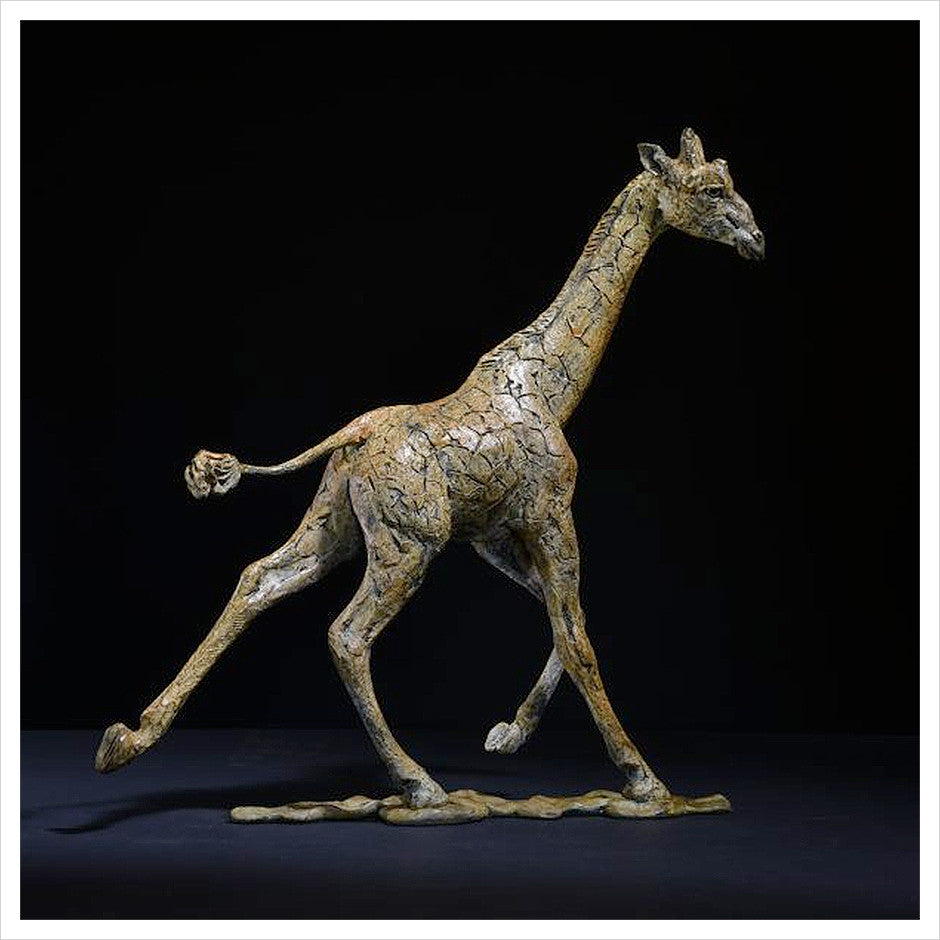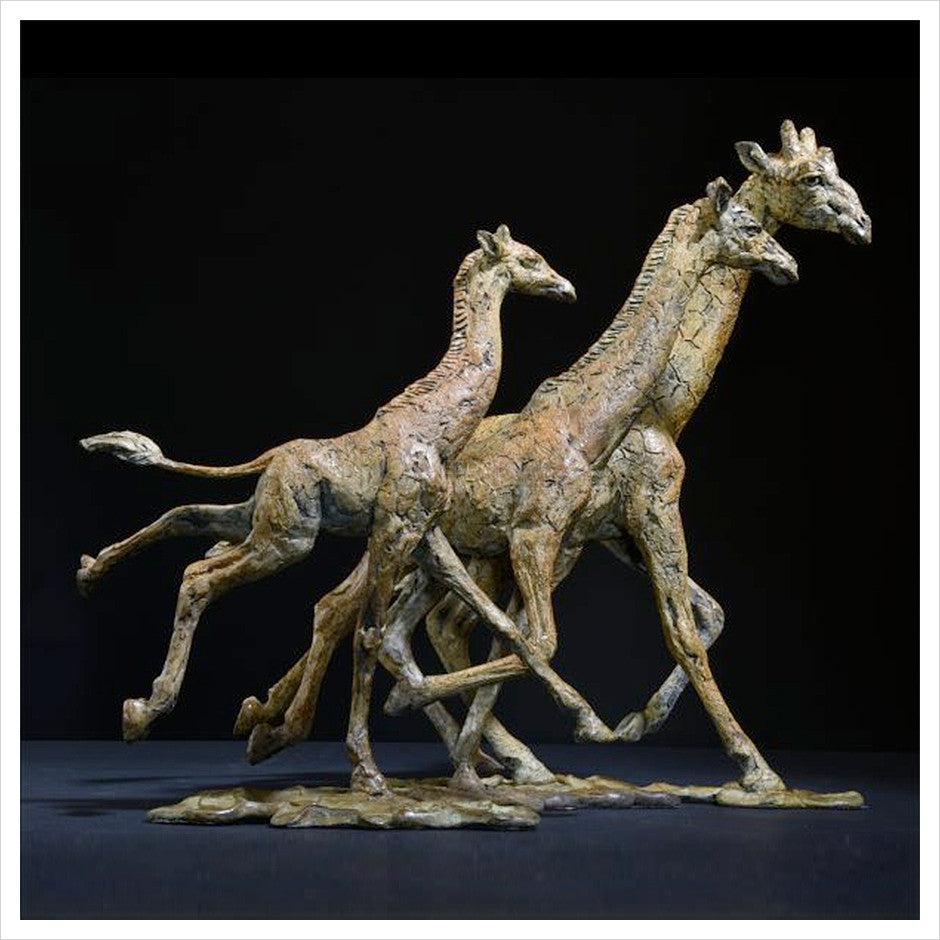Hamish Mackie
Giraffe Male
Giraffe Male
This sculpture is available to buy.
Please telephone or email for full details.
Telephone: 01425 655576
Email: post@collierdobson.com
Go back to: All Sculpture
See all works by: Hamish Mackie
Description and Dimensions
Description and Dimensions
- Bronze Sculpture
- Signed by Hamish Mackie
- Numbered edition of 12
- 46cm x 43cm x 14cm approximately
Biography
Biography

Hamish Mackie describes his bronze sculptures as coming from a traditional background; the original is closely observed from life and then cast into bronze. However, Hamish's method is loose and energetic, creating his own interpretation of the subject, which enables him to capture power and movement. Establishing himself as one of the top British wildlife sculptors, Hamish has been sculpting as a career since 1996 and has works in public and private collections around the world.
Born in 1973, Hamish Mackie is largely self taught as a sculptor. He grew up on a farm in Cornwall and began sculpting at Radley College, before going on to study at Falmouth School of Art, and Kingston University.

His sculptures are created on a foundation of anatomy and form. This generates a surface that exudes energy, spirit and character. He does not aim to render a photographic representation of the subject, but instead his own perception of the soul of the animal. His works explore a spectrum of emotions ranging from power through grace to intelligence. Hamish's manipulation of his materials is critical to achieving this, often leaving dramatic visible traces of the sculpting activity, the bronze then keeps this surface liveliness when it is cast.
Hamish works closely with the Foundry, pushing the boundaries of casting metals such as bronze, silver and stainless steel. Simon Allison who runs Lockbund Sculpture Foundry has always said, "You sculpt what you want and we'll work out how to cast it." Hamish has taken up this challenge working closely with Lockbund for 17 years creating sculptures as small and delicate as the diving Kingfisher as well as monumental outdoor installations.
Hamish has recently won a major public art commission for six life and a quarter size bronze horses for Berkeley Homes Goodman’s Field development in London. This is a year long project involving six different breeds of horse ranging from the elegant and exotic Arab to our home-grown powerhouse, the Shire. By the time the commission is finished it will have incorporated six tonnes of clay, one tonne of silicon rubber and three tonnes of bronze.
Whilst working flat out on the commission Hamish admits time in the studio is also a time to reflect on past works and look forward to consolidating new ideas. Future plans include more ‘fossil hybrids’ and more travelling. Not long returned from dromedary excursions in Dubai and elephant spotting in Namibia, Hamish’s next trip is to Russia where he looks forward to sculpting Arctic Turns, Ospreys and Fish Eagles.
Bronze Casting
Bronze Casting
Hamish has always been fascinated by the fact that it is technically possible to reproduce the detail of a fingerprint in bronze. "It's easy for me to push my fingers into wet clay, not so easy to reproduce it in metal."
Bronze castings are made by pouring molten bronze into a ceramic investment - known as the Cire Perdue or 'Lost wax' Method. This remains essentially the same technique as it was in 2,000 BC. The skill of transforming one material into another is to lose none of the original detail.
Hamish's sculptures are cast in England at the Lockbund Sculpture Foundry, Oxfordshire and Atelier Fine Art, Hampshire. "Who's enthusiasm and skill is elemental to what I do." The stainless steel Tuna was cast by the alloy specialist Lost Was Developments.
The first stage of making a bronze is to sculpt the original out of clay, plaster or wax. Hamish uses different materials depending on where and what he is sculpting. This is built up over a steel and aluminium anatomical skeleton known as an armature.
Over the original a silicon rubber mould is made to form a negative of the original.
Into the mould molten wax is slushed in and then poured out and allowed to cool, to form a hollow wax positive.
The seam line where the mould fitted together is then worked out and the sculpture cut up into castable sections.
To this a series of wax runners and risers is fitted, and these allow the molten bronze to flow in and the gases to come out. Once the wax is 'sprued up' it is coated inside and out with liquid ceramic and grit built up in layers to form a strong heat-resistant investment around the wax.
This is then baked upside down in an oven allowing the wax to melt out - hence the term 'Cirdu perdue or lost wax'.
This forms a negative space of the original into which molten bronze can be poured at 1200°c. Other metals such as gold, silver and stainless steel can be cast using the same method.
When the bronze has cooled, the ceramic shell is chipped away and the sprues cut off. To remove the ceramic from the surface detail the bronze is placed in acid, which breaks down the investment.
If the bronze has been cast in several pieces, it is now welded together and chased. This is a highly skilled process recreating any surface detail.
The sculpture is now ready to be heated up and applied with various chemicals, which form the finished patina. Hamish is one of few sculptors who do their own patination, considering this in his mind as important as the colour of paint on a canvas.









